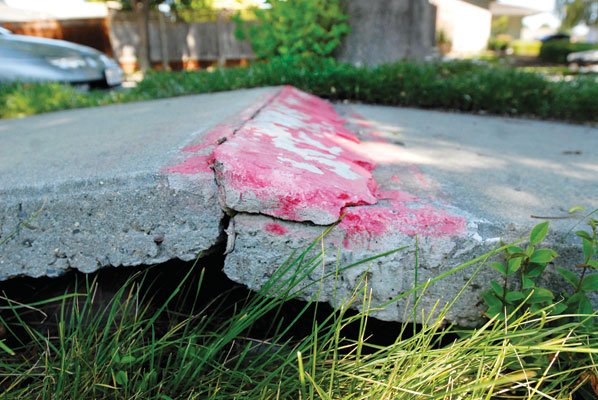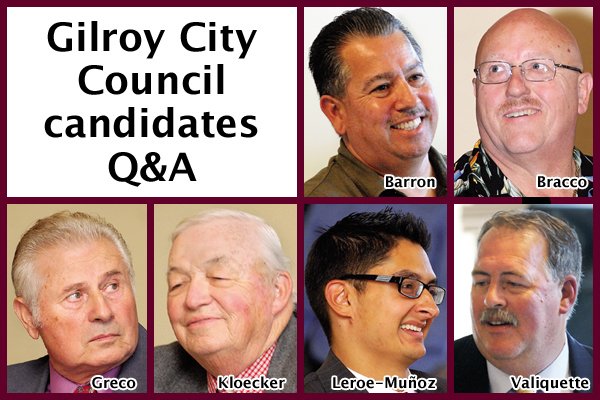At a time when City Hall is pinching every penny, cutting money
for softball supplies and laying off dozens of employees, four City
Council members stuck to their expensive campaign promises to fix
sidewalks.
GILROY
At a time when City Hall is pinching every penny, cutting money for softball supplies and laying off dozens of employees, four City Council members stuck to their expensive campaign promises to fix sidewalks.
Councilwoman Cat Tucker cast the deciding vote Monday night to spend another $350,000 this year to help residents fix their sidewalks, bringing the city’s year-to-date expenses to $875,000. The additional money is about how much three full-time employees cost the city, including benefits. If the extra cash runs out, the council also voted to issue IOUs to property owners to redeem next fiscal year.
The council split on the additional funding issue Dec. 1 with a 3-3 vote. Tucker was sick that night, but she joined Councilmen Craig Gartman, Perry Woodward and Bob Dillon Monday night, all four of whom promised residents during their campaigns that they would have the city cover 100 percent of repair costs.
There are 89 property owners on the waiting list for the city’s 80-20 program, whereby residents evenly split the cost of sidewalk repair with the city and then pay nothing for new curb and gutters, asphalt and tree removal – which ends up with residents footing about 20 percent of the total cost. So far this year, 103 properties have taken part at about $5,100 per repair. That means the extra funding should cover about 68 of the 89 property owners, leaving 21 with IOUs in their hands. Another $350,000 will become available July 1, 2009, when the next fiscal year begins.
Mayor Al Pinheiro’s preferred having residents wait until then.
“I think if these people have waited all these years to fix their sidewalks, they can wait another six months. We’re putting ourselves at risk, and there’s no reason we can’t wait six months,” Pinheiro said.
The four mostly let their votes do the talking, but Councilman Craig Gartman coyly called Pinheiro out when the mayor said the council should put sidewalks to the side because the cash-strapped city also has financial obligations to build major infrastructure projects, including Gilroy’s $6.5 million share of the sports and aquatics facilities at the new high school.
Unless property and sales tax receipts make U-turns, money for the facilities will come from the general fund reserve, which insures another $25.5 million worth of infrastructure and public facility projects that were supposed to draw funds from fees that developers have stopped paying because they have stopped building. The reserve held $26 million a year ago, but staff expects the balance to drop to $8.7 million by June 2009, and down to negative $11.5 million a year later.
“I don’t know why some council members think (sidewalks are) so much more important than having this money kept as money we can use when things are getting much worse,” Pinheiro said.
Gartman disagreed.
“Someone said they’d rather spend money in a swimming pool than on sidewalks,” Gartman said with a slight smile before recommending the IOU idea.
The extra $350,000 will come from the city’s gas tax fund, which also serves as an emergency backup for salaries in case the city’s cash-strapped general fund and the general fund reserve run out. Officials expect this year’s general fund deficit to total $2.3 million after the council has voted to lay off 46 full-time and 12 part-time employees – about 16 percent of the city’s workforce. That move, along with cuts to infrastructure projects and reductions in materials and services, helped City Administrator Tom Haglund narrow Gilroy’s deficit from $6 million two months ago down to $2.3 million.
For Councilman Peter Arellano, all these negative numbers made it clear that sidewalks could wait.
“I don’t understand why we’re setting the city up for going into the negative,” Arellano said. “We’re talking about trying to be diligent about our city’s finances, and we’re taking risks, and I think we’re taking an unnecessary risk.”
Councilman Dion Bracco, the third no vote, disagreed with the timing.
Drivers and businesses are pumping fewer gallons, he said, and the price of gas has dropped significantly, so the next round of taxes the gas fund receives from the state will be markedly lower. Last fiscal year, Sacramento gave Gilroy $900,000, and officials project about the same this year.
To cushion state receipts, though, the city budget maintains a balance of at least $2.2 million “to meet unanticipated costs,” City Administrator Tom Haglund said. These include repair costs for poles and roadways damaged by accidents, as well as “the extreme volatility of pavement and electrical costs” and oil prices, which all affect the price of road repairs and electricity for street lights and traffic signals. Now the fund will carry a balance of $1.8 million, the minimum Haglund recommended.
“Our maintenance projections don’t include future, unbuilt streets that need maintenance and signals,” Haglund said. “The reality is that even with the current development downturn, this fund is unlikely to stay static with respect to the number of facilities it needs to maintain over the years.”
While taking $350,000 from the account will make it harder to weather unseen costs in the future, that number is a far cry from the $2 million the council directed staff to come up with for sidewalk repair at the end of September.
At its Sept. 29 meeting, the same split council decided to fund 100 percent of sidewalk repairs provided it can later agree on how to fund the program. That was before the city began grappling with gang-related shooting. But even then, Bracco stressed that the city needs a plan before it “throws money away” that could otherwise hire more police officers.
The council also voted 5-2 that night to direct staff to come up with $2 million to begin fixing the sidewalk problem, whether that money comes from delaying future projects, the reserve fund or the city’s stressed general fund. Saving jobs has since taken most of the precedent.
Another contentious policy the council has left to discuss is the city’s street tree policy. Until recently, the policy required city trees with concrete-cracking roots to be planted between the curb and sidewalk. However, the city still has not prepared a replacement policy, which begins with the Parks and Recreation Commission that will work on a revised one throughout the next year.
The 80-20 program will continue until the council identifies a new funding mechanism to cover 100 percent of residents sidewalk repair costs. There will be no reimbursements for property owners who have already fixed their own sidewalks.
When it comes to the finances of sidewalk repair, some of the residents who have participated in the 80-20 program hired their own contractors and then billed the city for its 80-percent portion while others had the city do all the work and then sent in a check for about 20 percent. When the city does the legwork, it adds costs to bid the project, clear out the physical area, set up traffic controls and inspect the work, according to City Engineer Rick Smelser. A resident can get things cheaper, though, by avoiding overhead costs and government wage requirements that the city must abide by when it sends large projects out to bid.
The $11 million projection represents how much repairing all the sidewalks will cost if the city hires contractors, versus the $7 million if residents hire the labor. According to a summer sidewalk survey, though, the city likely has millions more in costs and more than 14 years of repairs at the current pace.















